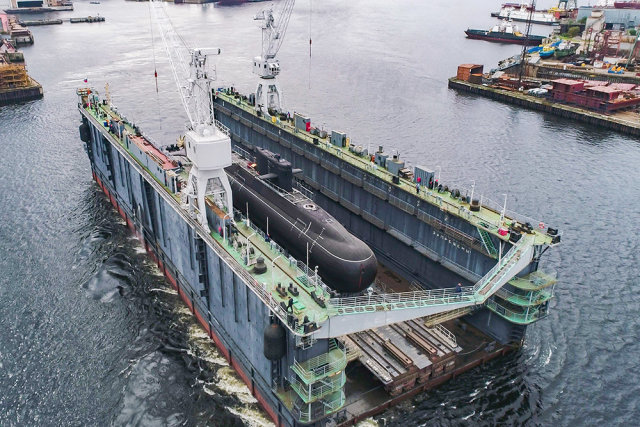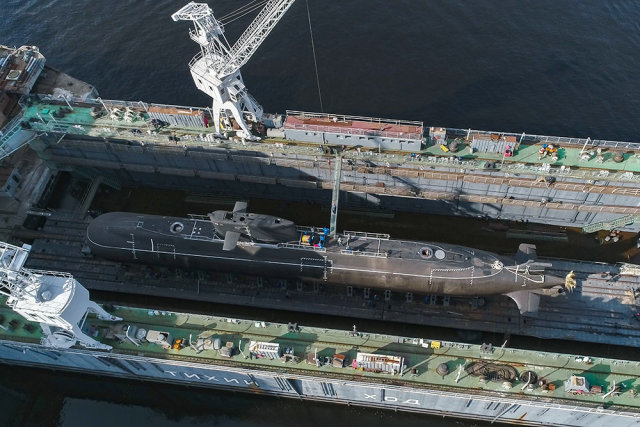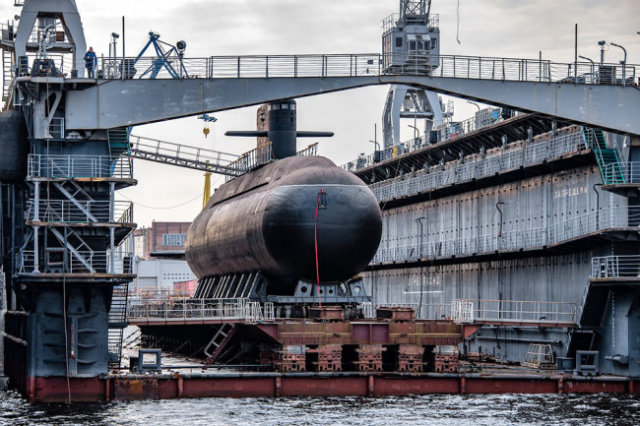Today, on March 26, a large diesel-electric submarine "Magadan" is launched at the Admiralty Shipyards in St. Petersburg. As already reported, it was built according to the project 636.3 of the Central Design Bureau "Rubin" for the Pacific Fleet and will be the third in a series of six similar ships that are assigned to serve on the Far Eastern borders.
Two first-born - "Petropavlovsk-Kamchatsky" and "Volkhov" - have already completed the required tests, have been accepted into the Russian Navy and are preparing for the inter-fleet transition from the Baltic to the Pacific Ocean. It was planned to take a southern route-through Gibraltar, the Mediterranean Sea and the Suez Canal. And there is an emergency-a giant container ship that ran aground completely blocked traffic, and they can't unblock the channel yet. It is clear that the sailors gathered on the road are worried about when and how the situation will be resolved.
The crew of the Magadan submarine, which has not yet seen its ship afloat, now has other concerns - it is completing training at the Obninsk Naval Training Center. According to the Department of Information and Mass Communications of the Russian Ministry of Defense, the planned training cycle for the team of the Magadan submarine is calculated until the end of April, "after which the submariners will begin to master the entrusted equipment and weapons systems directly on the submarine, as well as ensure its testing after completion on the water."
Crew training is conducted using the latest training and training complexes and specially developed programs that take into account "a number of innovative solutions implemented in the design of a series of submarines of Project 636.3, being built for the Pacific Fleet." And there are a lot of such "targeted" innovations-this is confirmed both in the design bureau "Rubin" and in the General Staff of the Navy.
"The series of non-nuclear submarines being built for the Pacific Fleet embodies the joint efforts of the Main Command of the Navy, designers, shipbuilders and cooperative enterprises to further develop Project 636.3 in accordance with the dynamics of scientific and technological progress," Admiral Nikolai Evmenov, the Commander - in-Chief of the Navy, made it clear. According to him, "Petropavlovsk-Kamchatsky", "Volkhov" and "Magadan", launched today, take into account "the specifics of their operation in the conditions of the Far East".

Recall that this is the second series that is being created for the Russian Navy under project 636.3. The first in 2010-2016 were designed, built, passed all types of tests and handed over to the customer six similar submarines for the Black Sea Fleet. Including the Rostov-on-Don, which recently distinguished itself in the Mediterranean.
The initial TTH of submarines of the project 636 are known: the autonomy of navigation - 45 days, the maximum depth of immersion-300 m, the speed of the underwater course-18 knots. The special feature of the Project 636.3 DAPL is the equipment of the Kalibr-PL strike missile system and new radio-electronic equipment.
The Central Design Bureau "Rubin", in turn, notes that the project 636.3, which is under construction of the series, in accordance with the instructions of the Ministry of Defense of the Russian Federation "is deeply modernized and meets all modern requirements." The designers initially laid in this series the possibility of deep modernization. The main positions here are ensuring an increasingly high level of stealth, the ability of the submarine to detect the enemy first, convenience and safety in operation, and increasing combat effectiveness. The complexes and systems installed on these submarines confirmed the declared characteristics during the tests of the first two ships of the Pacific series - Petropavlovsk-Kamchatsky and Volkhov. And these tests were carried out with the active participation of Rubin specialists.
Today's birthday "Magadan" is, strictly speaking, already the 72nd submarine of the original series "Varshavyanka" (it includes the ships of project 877 and project 636 in its development). They were built in the USSR from the beginning of the 80s at four shipyards - in Leningrad (St. Petersburg), Severodvinsk, Komsomolsk-on-Amur and Gorky (now Nizhny Novgorod). They were built for their Navy and for export - in particular, for the navies of China, Vietnam and Algeria.
It would seem that the affairs of long-forgotten days, the traditions of the old deep-what is there to talk about? What innovations? But let's listen to what the general director of the Central Bank "Rubin" Igor Vilnit says. "The modernization potential of the Varshavyanka series submarines has not been exhausted after 40 years of development, and the best proof of this is the order of these ships by the Russian Navy," he said on the eve of the launch of the Magadan .

And a little earlier he spoke even more definitely: "Project 636.3, developed by order of the Russian Navy, is a deeply modernized submarine, which has nothing in common with the original Varshavyanka ,in fact, only the hull. The requirements for submarines have changed today, but the significant modernization reserve originally laid down in the project allows us to take this into account. The combat effectiveness of modern diesel-electric submarines of Project 636 is significantly higher than those that were built in the past. In the foreign market, we offer the next-generation project - "Amur 1650", but "Varshavyanka" also retains its position. It can be delivered in various modifications, including the installation of equipment of a foreign customer."
Together with the " Magadan "at the end of 2019, a similar DAPL" Ufa "was laid on the slipway of the"Admiralty Shipyards". The laying of the fifth and sixth such submarines is planned for this year, 2021. It was reported that they will receive the names "Mozhaisk" and "Yakutsk". Most recently, on the eve of the Day of the Submariner, Admiral Nikolai Evmenov expressed confidence that the entire series of six non-nuclear submarines of the project 636.3 for the Pacific will be built and put into service no later than 2024. And this, according to the commander-in-chief, " will allow us to raise to a new qualitative level the solution of tasks by the Pacific Fleet in its operational area of responsibility."
In the meantime, in the Pacific Fleet, next to the fourth-generation nuclear missile carriers of the Borey series, there are still submarines-the harbingers of the Varshavianok-the Project 877 "Halibut"DAPL.
Alexander Emelianenkov

